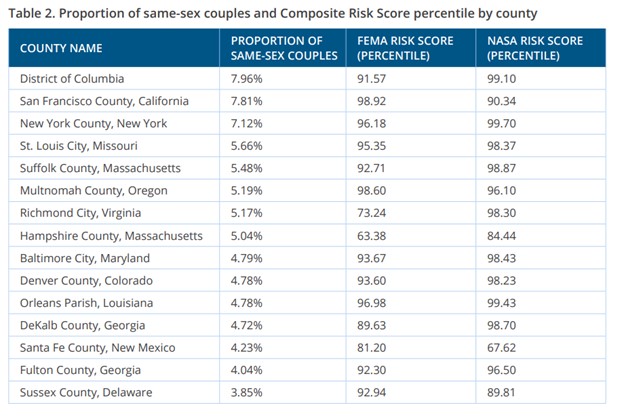LGBTQ People Face Greater Climate Risks
A new study by the UCLA Williams Institute finds that LGBTQ people in same-sex couples are at greater risk of exposure to the harms of climate change compared to straight couples.

In August of 2005 when Hurricane Katrina made landfall in Louisiana and Mississippi, the combination of torrential rain and flawed infrastructure proved deadly. More than 1,800 people died and the price tag for the damage quickly rose to the tens of billions of dollars. In the chaotic disaster response that followed, several communities were disproportionately vulnerable to discrimination during recovery. Among them: LGBTQ residents. They were often overlooked in local and national relief efforts, which routinely failed to recognize households of same-sex couples as “families.” Some LGBTQ families faced separation during resettlement. Many more people struggled to apply for relief aid, especially because churches and religiously affiliated organizations so often provided the relief. And these challenges largely went unnoticed in media coverage and subsequent research, as written about here.
As extreme weather events—including increasingly powerful storms—become more common, experiences like this will also become more common. Flooding, storm surges, evacuations, and other effects of climate change will be disproportionately felt by LGBTQ communities. Some new research makes that connection.
A recent report by the Williams Institute at UCLA School of Law finds that LGBTQ people in same-sex couples are at greater risk of exposure to the negative effects of climate change compared to straight couples. The authors say this report “provides some of the first empirical documentation showing how LGBT people are at greater risk to the negative effects of climate change compared to non-LGBT people.”
Key findings include that LGBTQ people in same-sex couples are disproportionately located in counties with greater risks of climate hazards. Same-sex couples are also more likely to reside in communities with poorer infrastructure and less access to resources. As a result they are, the report says, less prepared to “respond and adapt to natural hazards and other climate disruptions.”
The study’s authors came to these findings by analyzing data on same-sex couples taken from the 2020 U.S. Census. They then compared this to data on climate risk projections from two sources—NASA, which focuses primarily on changes to meteorological patterns, and FEMA, which focuses on changes in the occurrence of severe weather events. (They point out that no national surveys that collect data on the LGBTQ status of individuals have sufficient data at the county level and that “the use of same-sex couples as a proxy for LGBT individuals does not capture LGBT persons who are not living in same-sex couple households…Nevertheless, same-sex couples are the best available measure for geographically specific data on this population and are commonly used in research addressing LGBT people.”)
We know that the effects of climate change amplify existing inequities when it comes to race and income. This research shows us one more way in which that’s true. This means that going forward it’s important that policymakers in states and counties across the country consider the vulnerabilities of LGBTQ populations when crafting disaster preparedness, response, and recovery plans.
Some right-wing media homed in on this research study to write dumb headlines like this one from the Washington Examiner, “Study: LGBT people are more likely to be rich coastal elites” (I’m not dignifying it with a link). It’s worth pointing out what’s wrong with that assessment because it goes to the heart of these findings. Among the 15 counties researchers surveyed with the highest proportions of same-sex couples and the highest climate risks, there were many that are not what you’d call bastions of “coastal elites.” Municipalities on the list include St. Louis, Missouri; Richmond, Virginia; Denver, Colorado; Dekalb County GA; and notably Orleans Parish, Louisiana—where New Orleans suffered from that deadly combination of hurricane plus poor infrastructure back in 2005.

“More LGBT people live in the South than any other region, so it’s far from a story of “’coastal elites,’” Ari Shaw told me in an email. Shaw is co-author of the study and Senior Fellow and Director of International Programs at the Williams Institute. The right-wing knee-jerk reaction is also wrong because LGBTQ people are more likely to live in poverty and face food insecurity than straight people, according to other research by the Williams Institute. “In the report we show that same-sex couples are at greater risk because they live in communities that have poor infrastructure and less access to resources that hamper adaptation and resilience, whether they live in a city or not,” Shaw added.
This area of study is bound to expand. Last November, the U.S. Global Climate Research Program released its Fifth National Climate Assessment. And for the first time, this important interagency report included a section on “how social, economic, and health disparities among LGBT people, and especially those experiencing multiple and intersecting forms of marginalization, likely create unique risks to and challenges mitigating the harms of climate change.”
Shaw says we need much more research. “I’d also like to broaden the scope to think more globally about how climate impacts LGBTQ people… I’d love to think more about how climate is impacting migration, conflict, economic security, public health, and other global dynamics that are also likely disproportionately impacting LGBTQ people.”







Reader Comments